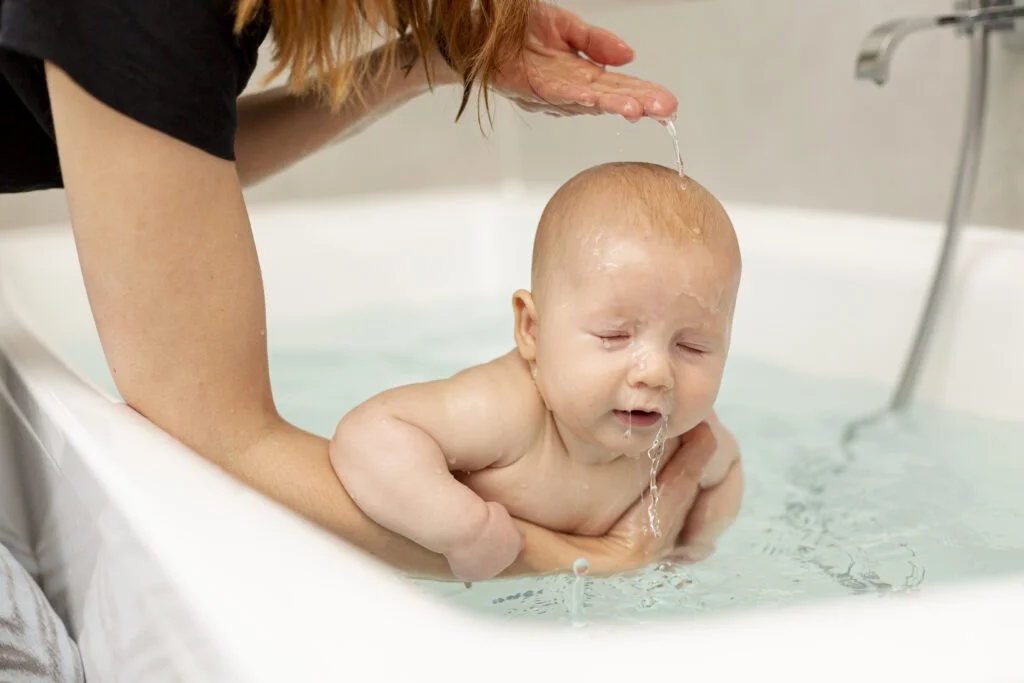Introduction
What is a baby walker used for? Many new parents ask this question as they try to find ways to support their baby’s early movements. A baby walker can seem like an exciting tool that encourages your little one to take those first steps. While walkers are designed to help babies move around before they start walking on their own, they have more uses than just mobility. In this article, we’ll explore the many surprising uses of a baby walker and how it can benefit both you and your baby during their early development.
#1 Helps Babies Move Around Before Walking

One of the main reasons parents use baby walkers is to help their babies move before they start walking independently. Walkers come with wheels and a supportive frame, allowing babies to push themselves around while still sitting.
This mobility helps babies explore their surroundings in a new way, encouraging curiosity and early physical activity. While a walker does not teach your baby to walk, it helps them practice movement and build confidence in their ability to get around.
At what age can babies use a walker?
Babies can typically use a walker around 4 to 16 months old. However, it’s best to wait until they can support their weight and stand with assistance. Always supervise them to ensure safety during use. This helps promote proper development and reduces the risk of falls.
#2 Encourages Early Motor Skills Development
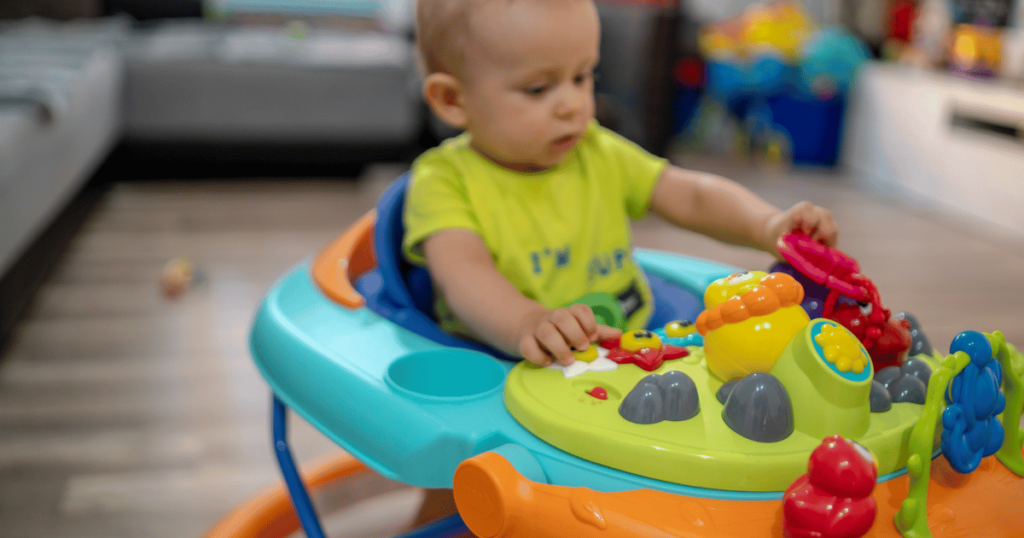
A baby walker encourages the development of gross motor skills. As your baby pushes themselves around, they’re using their legs and feet to move the walker. This exercise strengthens their leg muscles, which is essential for walking later.
While using a walker, babies also learn to balance and coordinate their movements. These physical skills are critical in their overall motor development and will help them achieve other milestones like standing and walking.
Do baby walkers help with motor skills?
Baby walkers may not significantly improve motor skills. They can encourage movement, but they also restrict natural development. Experts recommend allowing babies to practice crawling and standing instead. This promotes better coordination and strength, which are essential for future walking and overall motor skill development.
#3 Provides Entertainment and Engagement
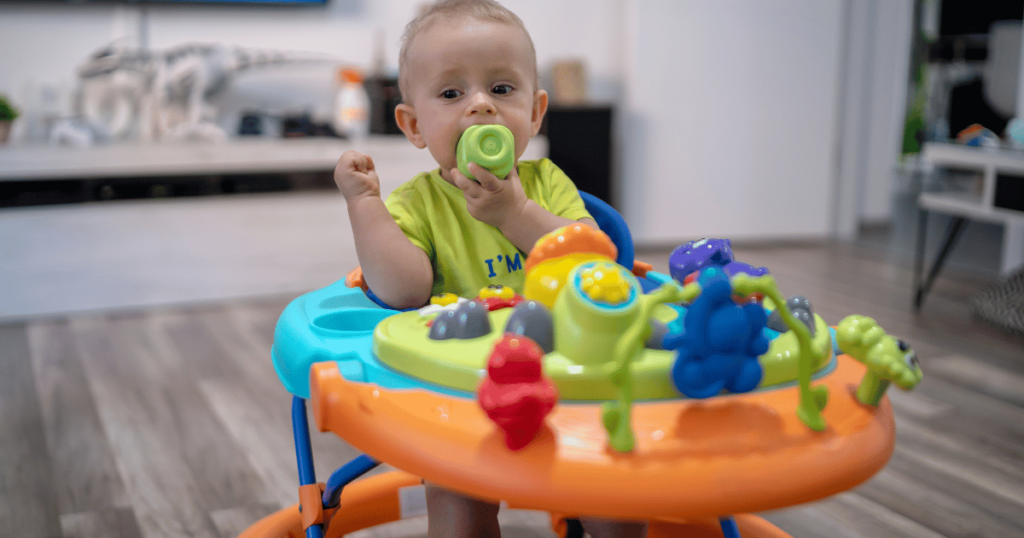
Many baby walkers come with built-in toys, lights, and sounds that can keep babies entertained for hours. This feature makes walkers more than just mobility tools. They are also great for providing sensory stimulation and entertainment.
Walkers with interactive features can help babies develop their hand-eye coordination as they reach for toys and press buttons. The added stimulation can also contribute to cognitive development, as babies learn cause and effect by interacting with the different toys and sounds.
What toys are typically included with baby walkers?
Baby walkers often include various toys to engage infants. Common items are colorful rattles, spinning toys, and soft plush figures. Some may feature interactive buttons that play sounds or music. These toys aim to stimulate a baby’s senses while encouraging them to explore their surroundings safely.
#4 Gives Parents a Short Break
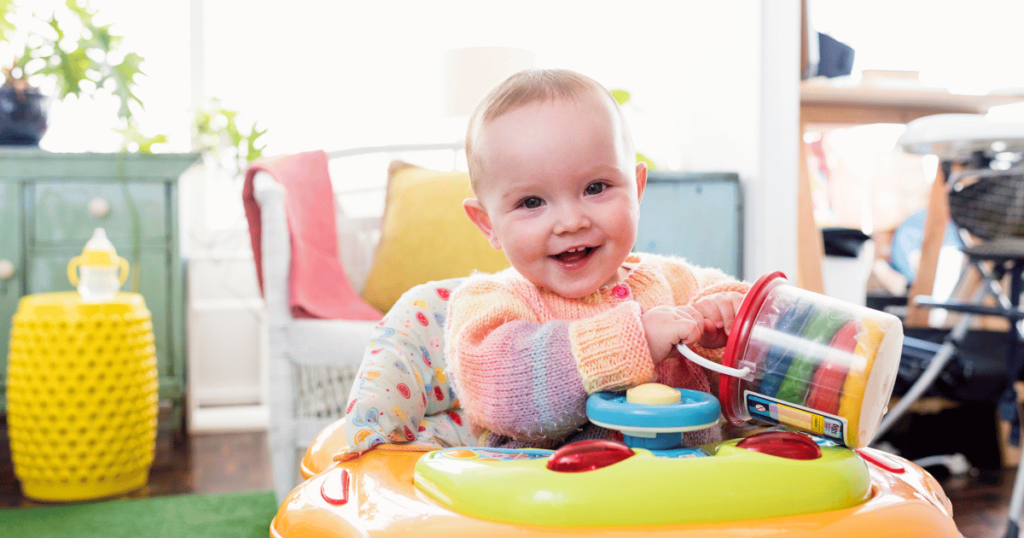
Parents love baby walkers because they provide a safe place for babies to play and explore while giving the parents a short break. As long as the baby is supervised, a walker can give them the freedom to move and play in a contained space while parents attend to other tasks.
However, it’s important to remember that babies should not spend too much time in walkers, and they should always be supervised to prevent any accidents. Walkers are a helpful tool, but they are not a substitute for constant supervision.
Do baby walkers assist parents in multitasking?
Yes, baby walkers can assist parents in multitasking. They provide a safe space for babies to explore while parents attend to chores. This allows caregivers to keep an eye on their child without constant supervision. However, it’s essential to ensure the walker is used safely at all times.
#5 Improves Hand-Eye Coordination
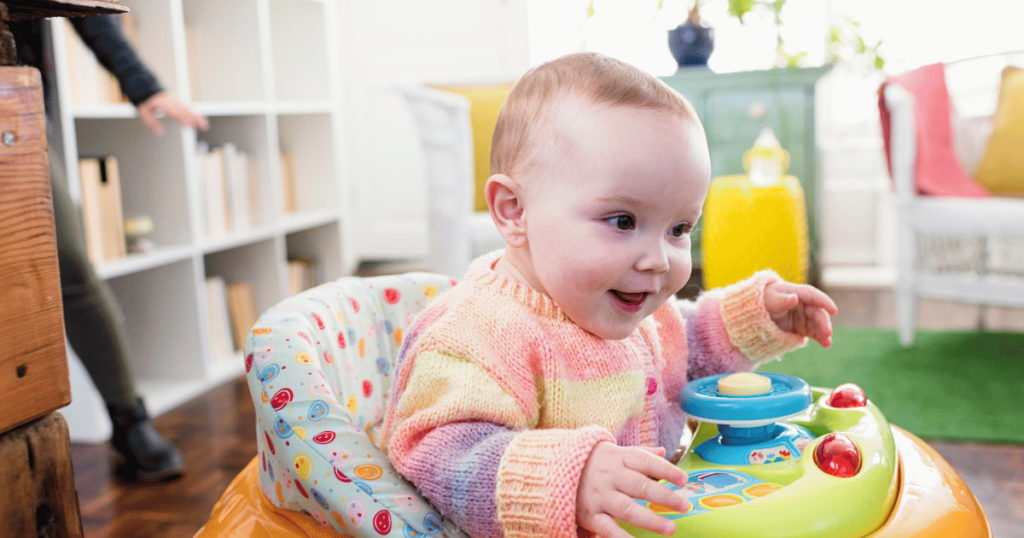
Using a baby walker can also help improve your baby’s hand-eye coordination. Walkers often have toys and objects within reach, encouraging babies to grab, push, and pull. These activities support the development of fine motor skills and coordination between what the eyes see and what the hands do.
Improving hand-eye coordination is crucial as it helps babies develop the skills they’ll need later for feeding themselves, playing with toys, and learning to write.
How do baby walkers help hand-eye coordination?
Baby walkers can enhance hand-eye coordination in infants. As babies reach for toys while moving, they practice grasping and aiming. This activity helps develop their visual tracking skills. Improved coordination sets a foundation for future activities, such as writing and playing sports, making it an important developmental tool.
#6 Introduces Babies to New Environments
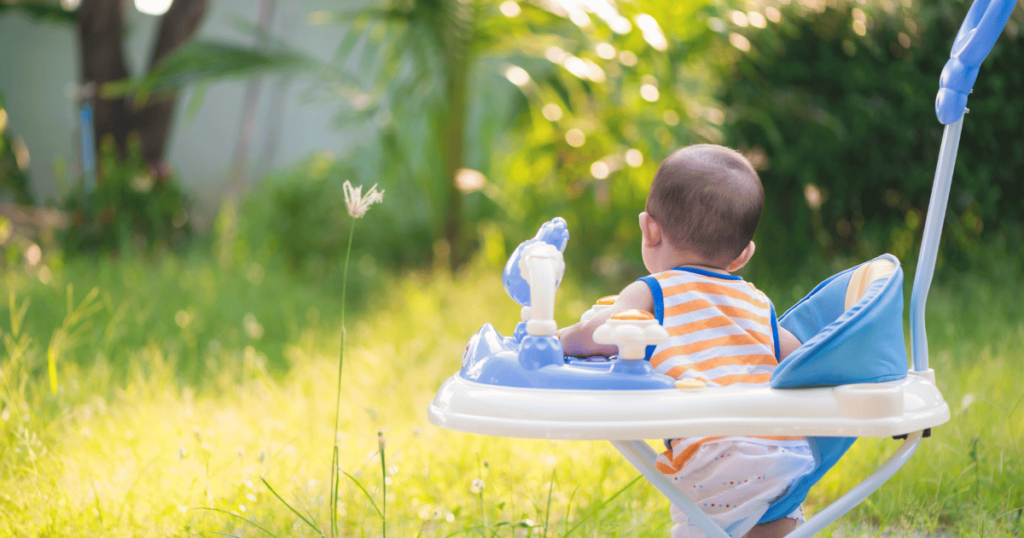
Another surprising use of a baby walker is introducing babies to new environments. With the help of a walker, babies can move around and explore areas they wouldn’t normally reach when crawling.
This sense of exploration helps develop their spatial awareness. They start to understand distances, objects, and how to navigate around obstacles. A baby walker lets them explore safely, as long as the environment is free of hazards like stairs and sharp objects,
Can baby walkers promote exploration?
Yes, baby walkers can promote exploration. They allow babies to move around and discover their environment safely. As infants navigate different spaces, they encounter new sights and sounds. This exploration is crucial for cognitive development and helps them learn about their surroundings in an engaging way.
#7 Strengthens Baby’s Leg Muscles
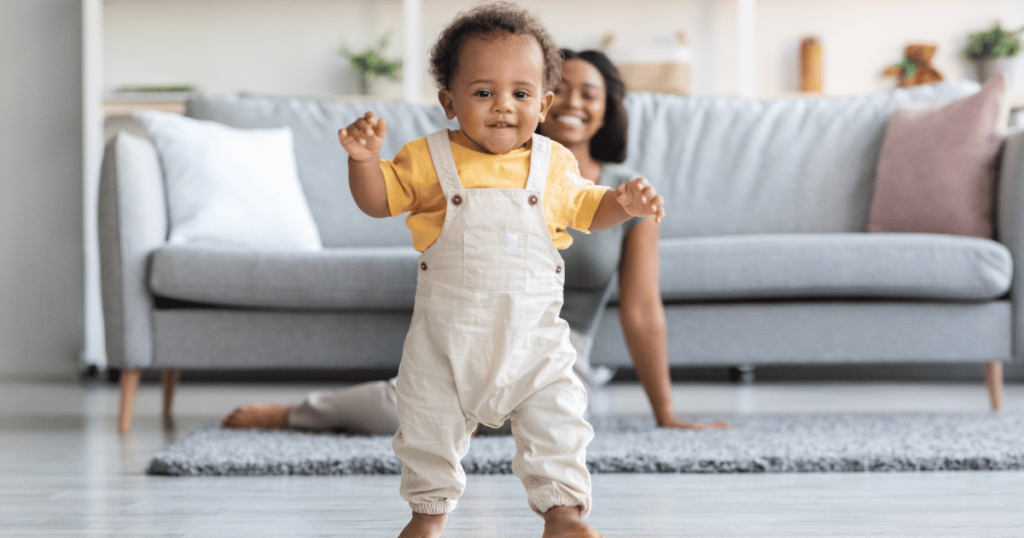
As babies use their legs to push the walker, their leg muscles get stronger. This activity prepares them for the next stage of walking. The constant movement also helps improve circulation and overall strength in their lower body.
By strengthening their leg muscles early on, babies are better equipped to stand and walk on their own when they are ready.
Does a baby walker help strengthen legs?
Yes, baby walkers can help strengthen infants’ legs. When babies push off the ground, they engage their leg muscles. This activity supports muscle development and balance. However, it’s important to combine walker use with other activities that encourage crawling and standing for overall leg strength.
Choosing the Right Baby Walker

When choosing a baby walker, consider the following factors:
- Safety Features: Make sure the walker has a sturdy frame and safety locks to prevent accidents.
- Interactive Toys: Look for walkers with engaging toys that promote learning and development.
- Comfort: Ensure the seat is well-padded and comfortable for your baby.
- Adjustability: Choose a walker that can adjust to different heights so it grows with your baby.
Common Concerns About Baby Walkers
Are baby walkers safe for babies?
Baby walkers are safe when used correctly and under supervision. Make sure the area is free of hazards, and always stay nearby.
Can a baby walker delay walking?
No, but it’s important not to leave babies in walkers for too long. Too much time in a walker can limit floor play, which is important for developing natural walking skills.
How long can babies use a walker?
It’s recommended that babies use a walker for short periods, around 15 to 20 minutes at a time. Too much time in a walker can lead to over-reliance on the tool.
Is it appropriate for a 4-month-old baby to use a walker?
A 4-month-old baby is generally not ready to sit in a walker. At this age, babies lack the muscle strength and coordination needed to safely use a walker. Walkers are designed for babies who can sit up on their own and have some control over their movements. It’s better to wait until the baby is around 6 to 8 months old, when they can sit without support.
What is the best baby walker?
The best baby walker should be safe, sturdy, and comfortable for your child. Popular options include the Joovy Spoon Walker and the VTech Sit-to-Stand Learning Walker. Look for walkers with safety features like a wide base, non-slip grips, and adjustable height settings. Make sure it meets safety standards and fits your baby’s development stage.
What are the disadvantages of a baby walker?
Baby walkers can cause delays in walking because they allow babies to move without learning how to balance. They also increase the risk of accidents, such as falls or reaching dangerous objects. Many experts discourage the use of walkers, as they can lead to muscle development issues and safety hazards.
What’s the difference between a baby walker and a stationary walker?
A baby walker is a device with wheels that lets babies move around. A stationary walker, on the other hand, stays in one place and often includes toys or activities to keep the baby engaged. Stationary walkers are considered safer as they don’t allow movement that could lead to falls.
What is the purpose of a baby walker?
A baby walker is designed to help babies explore their surroundings before they can walk on their own. It allows them to practice standing and moving, but it’s not essential for their development. Walkers provide entertainment and mobility, but should be used cautiously.
Can I put my 3-month-old in a walker?
No, a 3-month-old baby is too young for a walker. At this age, babies lack the strength and coordination needed to sit up or control their movements. It is recommended to wait until they are around 6 months old and can sit independently.
What is the right age for a baby walker?
The ideal age for a baby walker is between 6 to 8 months. By this age, most babies can sit up without support and have developed enough muscle strength to control their body movements. Always consult your pediatrician before introducing a walker to ensure your baby is ready.
Final Thoughts: What is a Baby Walker Used For?
Baby walkers are versatile tools that offer more than just mobility. They help strengthen leg muscles, develop motor skills, and provide entertainment, all while giving parents a short break. Walkers can also promote exploration and hand-eye coordination. However, it’s essential to use them in moderation and always under supervision to ensure safety.
If you’re thinking about getting a baby walker, be sure to choose one that offers both entertainment and developmental benefits. Remember, a baby walker is just one of many tools that can support your baby’s early growth. Balance walker time with plenty of floor play and other activities to help your baby thrive.
Other References
- American Academy of Pediatrics (AAP)
- What to Expect – March of Dimes
- KidsHealth from Nemours
- American Dental Association (ADA)
- WebMD
- What to Expect
- BabyCenter
- Verywell Family
- The Spruce
- Healthy Children
More to Read
- How to bathe a newborn baby in 13 steps: The comprehensive guide
- Getting the temperature just Right: A guide to baby bath water
- Bath Time: How often should you wash your little one
- Baby Bathtubs: The Best 5 Ways to Store Baby Bathtubs in 2024
- 4 Steps to Choose a Collapsible Baby Bathtub in 2024
- The Best 5 Baby Bathtubs for Small Space in 2024
- The Best 5 Inflatable Baby Bathtubs In 2024


